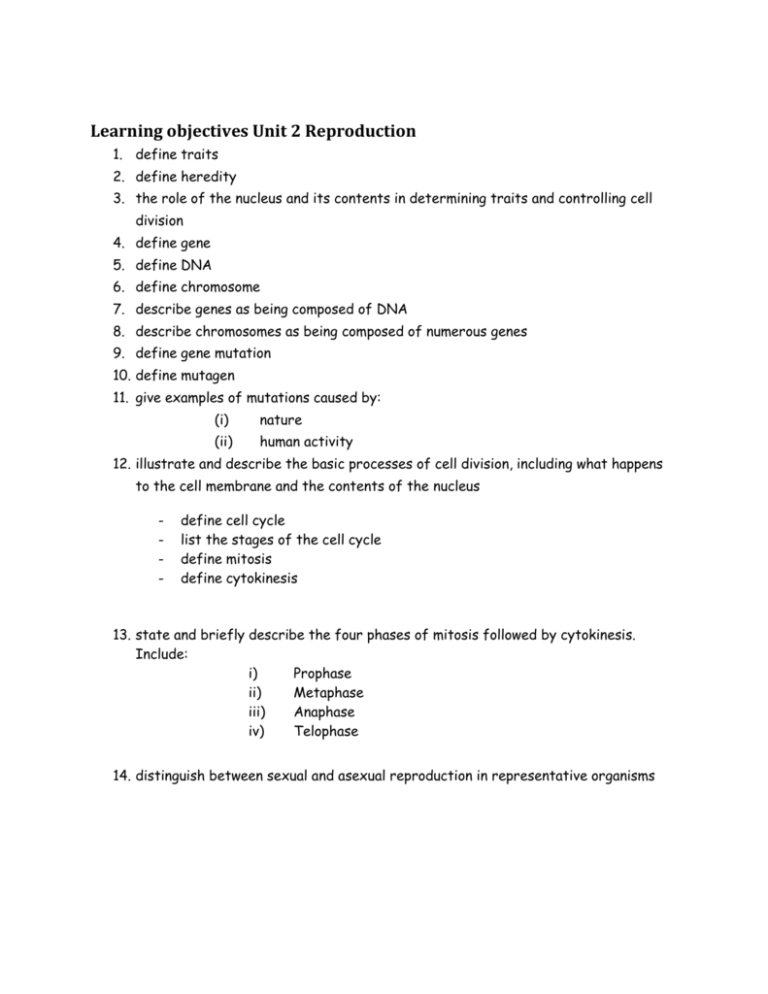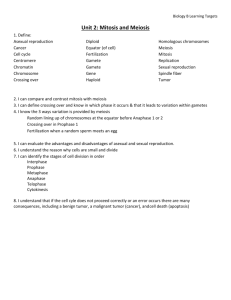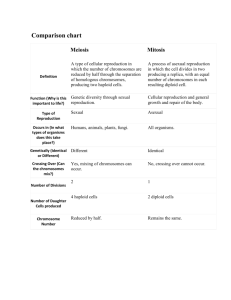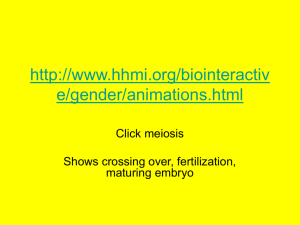g9Learning objectives Unit 2 Reproduction
advertisement

Learning objectives Unit 2 Reproduction 1. define traits 2. define heredity 3. the role of the nucleus and its contents in determining traits and controlling cell division 4. define gene 5. define DNA 6. define chromosome 7. describe genes as being composed of DNA 8. describe chromosomes as being composed of numerous genes 9. define gene mutation 10. define mutagen 11. give examples of mutations caused by: (i) nature (ii) human activity 12. illustrate and describe the basic processes of cell division, including what happens to the cell membrane and the contents of the nucleus - define cell cycle list the stages of the cell cycle define mitosis define cytokinesis 13. state and briefly describe the four phases of mitosis followed by cytokinesis. Include: i) Prophase ii) Metaphase iii) Anaphase iv) Telophase 14. distinguish between sexual and asexual reproduction in representative organisms 15. define asexual reproduction - explain methods of asexual reproduction using an example. Include: (i) binary fission (ii) budding (iii) fragmentation (iv) vegetative reproduction (v) spore formation 16. define sexual reproduction 17. define gamete, fertilization, zygote, embryo - describe the role of meiosis in sexual reproduction state and briefly describe the eight phases of meiosis define diploid define haploid describe interkinesis Meiosis I - Prophase I: homologues chromosomes pair up - Metaphase I: homologus chromosomes pair up at the equator - Anaphase I: homologuous chromosomes separate and are pulled to opposite poles - Telophase I: homologuous pairs have moved to opposite ends of the cell and cell begins to divide Meiosis II - Prophase II: nucleus contains only 1 chromosome from the homologous pair in each cell - Metaphase II: chromosomes line up at the equator - Anaphase II: half of the chromosomes are pulled to opposite poles - Telophase II: a nuclear membrane forms around each set of chromosomes and the cell begins to divide to produce four haploid gametes 18. compare and contrast mitosis and meiosis. Include: (i) types of cells (ii) number of daughter cells produced (iii) amount of genetic material in each daughter cell 19. Interkenisis: the cell grows and makes various proteins 20. distinguish between sexual and asexual reproduction in representative organisms 21. explain how various organisms reproduce sexually. Include: (i) moss (ii) flowering plant (iii) insect 22. incomplete metamorphosis 23. complete metamorphosis 24. compare and contrast complete and incomplete metamorphosis 25. compare and contrast external and internal fertilization 26. compare sexual and asexual reproduction in terms of their advantages and disadvantages meiosis and mitosis amount of energy required parental care genetic variety in offspring 27. provide examples of genetic conditions that cannot be cured using scientific and technological knowledge at the present time. Include: (i) Down syndrome (ii) Cystic Fibrosis (iii) Allderdice Syndrome 28. identify major shifts in scientific understanding of genetics. Include: (i) Mendel’s experiments (ii) Watson and Crick’s double helix model of DNA (iii) Human Genome Project (iv) genetic engineering 29. provide examples of how the knowledge of cellular functions has resulted in the development of technologies 30. provide examples of Canadian contributions to science and technology related to heredity and genetic engineering 31. evaluate information and evidence gathered on the topic of genetics and genetic engineering








